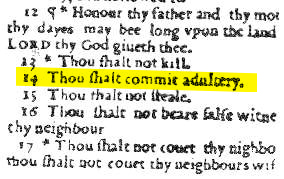 Submitted by Striker on
Submitted by Striker on

The Holy Bible consistently ranks as the top selling book and the world. An inspiration to millions of faithful, it is seen by many as the direct word of God. Whether this is true or not is more a matter of belief. What is true, however, is that the very physical form the Bible takes is produced by the hands of fallible humans.
The results of this collision between the human and the holy can be downright funny at times. One such incident occurred in 1631, when a seemingly innocent typo drastically changed one of the Ten Commandments. The resulting text caused quite a stir in its day. Known as “The Wicked Bible,” those copies of the text that survived destruction remain today as one of the rarest and sought after printings of the Bible in the world.
The Birth of Wickedness
The story began innocently enough. King Charles I of England ordered 1,000 copies of the King James Bible from London printers, Robert Barker and Martin Lucas. Now, it needs to be understood that printing then was not as simple as it is today. Early printing presses required printers to set each letter of type by hand. The process was painstaking and tedious, although it was leaps and bounds better than the previous method for producing books, which required people to laboriously copy texts by hand. Even so, printing was an error prone process, one that required careful proofreaders with sharp eyes to catch mistakes.
Evidently, Barker and Lucas’ proofreader was bad at his job, because a critical mistake made it into the edition. It was not discovered until after the 1,000 copy run was already being sold. One of the Ten Commandments, the seventh to be exact, was missing the word “not.” So, the text read: “Thous shalt commit adultery.”
Evidently, Barker and Lucas’ proofreader was bad at his job, because a critical mistake made it into the edition. It was not discovered until after the 1,000 copy run was already being sold. One of the Ten Commandments, the seventh to be exact, was missing the word “not.” So, the text read: “Thous shalt commit adultery.”
Needless to say, the mistake (if a mistake it was) caused a ruckus. King Charles I and the Archbishop of Canterbury were outraged at the typo. Barker and Lucas were hauled into court, where they were fined £300 (£35,000 in today’s money) and stripped of their printing license. All available copies of the so-called “Wicked Bible” were rounded up and destroyed. It is said that only a dozen survived, although some question that number because so many copies were sold before the alteration was found. In any case, it is a rare book that is highly sought after by collectors. It is hard to place a value on such a text, as other factors such as the quality of the specimen enter into the equation. Taking that into account, one copy is listed at $99,500. Most copies are probably worth far less, as this is a full retail price, but it does give an impression as to how much collectors might be willing to pay for this rare book.
A typo? Or a prank?
The generally accepted notion is that the infamous omission of the word “not” was a simple mistake resulting from the cumbersome and error prone 17th century printing process. However, there are some reasons to believe this might have been a deliberate act. The first is that there is another such error, this one in the Book of Deuteronomy. In chapter 5, verse 24, the word “greatness” was replaced with “great arse.” So the text read that God showed his glory and “great arse.”
One unfortunate typo is one thing, but two starts to show a pattern. George Abbot, the Archbisop of Canterbury, thought the error was due to shoddy workmanship. He was quoted saying:
“I knew the tyme when great care was had about printing, the Bibles especially, good compositors and the best correctors were gotten being grave and learned men, the paper and the letter rare, and faire every way of the beste, but now the paper is nought, the composers boyes, and the correctors unlearned.”
It is interesting to note that he said that the composers were “boyes.” The errors do have a sophomoric nature, especially the “great arse” line. It sounds like something a bored teenager would slip into a text if they thought no one was looking. Perhaps the printers hired the late medieval equivalent of temp workers, and a disgruntled young man subtly altered the text of the print to thumb his nose at his employer, or simply for the fun of it. Maybe he expected the “corrector” to catch the error before the book printed.
We can never know for sure whether this was the case or not. Simple human error could have inadvertently created one of the most infamous Bibles in history, but due to the nature of the “typos” a bored prankster seems more likely. Either way, the Wicked Bible will remain a historical curiosity, a testament to the fact that even humanity’s holiest works can be subject to a very human quality: imperfection.
Andrew Kincaid http://www.oddlyhistorical.com/2015/08/
Sources:
http://www.theguardian.com/books/booksblog/2010/nov/25/wicked-bible-gift-william-kate
http://www.greatsite.com/ancient-rare-bibles-books/platinum.html
http://www.fowlerbiblecollection.com/the-wicked-bible—king-james.html